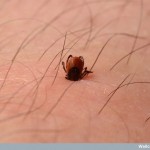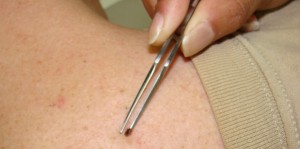It’s tick season and social media is blowing up with recommendations for removing ticks. Petroleum jelly, a hot match, twisting tools, and swirling with a cotton swab are a few on the list. They all promise to cause the tick to release with the head intact. People are very concerned about leaving the head behind.

But when it comes to ticks, the head and mouth parts are the least of your worries. Hot matches, petroleum jelly, etc. — just know that if the tick freaks out (and it will), more saliva — and pathogens — will get into you. May the thought of a tick spitting into your blood stream give you pause.
Though a literature review on tick removal techniques put out by the London based Health Protection Agency Centre for Infections shows the lack of research in this area, it concludes that grasping the head as close to the skin as possible using forceps or pointy tweezers and pulling straight up is the best method. This mirrors the current CDC recommendation and is what the NYS IPM Program advises.

And if you accidentally break off the head? Don’t sweat it. Just treat it like you would a splinter.
Want to see a video of the tweezer technique? Here’s a good one from the TickEncounter Resource Center.
After removing the tick, place it in a plastic bag, put the date on it, and stick it in the freezer. If you start to feel poorly in the next few weeks, take the tick with you to the doctor. Different ticks carry different diseases and knowing what species bit you can help the doctor decide on the best course of treatment.
Of course, avoiding being bitten is the best strategy of all. For more information on ticks, visit www.nysipm.cornell.edu/whats_bugging_you/ticks.